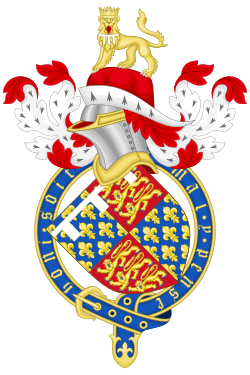Edward the Black Prince
Edward, the Black Prince (Woodstock Palace, Oxfordshire, 15 June 1330 – Westminster Palace, 8 June 1376) was the eldest son of King Edward III of England. He was elevated Duke of Cornwall in 1337.
| Edward the Black Prince | |
|---|---|
 Portrait, c. 1430s | |
| Prince of Wales | |
| 15 June 1330 - 8 June 1376 | |
| 12 May 1343 | |
| Predecessor | Edward of Caernarfon |
| Successor | Richard of Bordeaux |
| Born | 15 June 1330 |
| Died | 8 June 1376 (aged 45) |
| Spouse | Joan of Kent (m. 1361) |
| Issue | Edward of Angoulême Richard II of England Roger Clarendon (ill.[a]) |
| Father | Edward III of England |

Edward was born at Woodstock Palace, near Oxford. He was made Prince of Wales in 1343 and followed his father into battle against France. He became a famous soldier by helping to win the Battle of Crécy and commanding the Battle of Poitiers. He was a founding member of the Order of the Garter. In 1361, he married his cousin, Joan of Kent. They had two sons, Edward and Richard. The older son, Edward, died when he was only six.
Edward of Woodstock has become known in history as "the Black Prince". The nickname first appeared in print about 165 years after his death. He is thought to have dipped his armour in tar to stop it rusting, and is known to have used a black shield at times. He died at the age of 45 and was buried at the Canterbury Cathedral. As his father was still living, he never became king himself. He asked his father to give the title Prince of Wales to his son Richard, who later became King Richard II of England.
Edward The Black Prince Media
The Black Prince at Crécy by Julian Russell Story, 1888, shows the prince contemplating his slain opponent, King John of Bohemia. Telfair Museums, Savannah, Georgia
Edward is granted Aquitaine by his father King Edward III. Initial letter "E" of miniature, 1390; British Library, shelfmark: Cotton MS Nero D VI, f.31
Edward's signet ring, found in Montpensier, France in 1866. Now in the Louvre, Paris.
19th-century illustration of the Black Prince's march through Roncesvalles
The siege of Limoges in 1370
Edward's heraldic achievements on display in Canterbury Cathedral
Notes
- ↑ illegitimate









